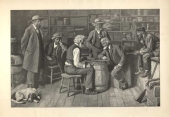The Checker Maven
The World's Most Widely Read Checkers and Draughts Publication
Bob Newell, Editor-in-Chief
Published every Saturday morning in Honolulu, Hawai`i
Noticing missing images? An explanation is here.
Lieber's Catapult
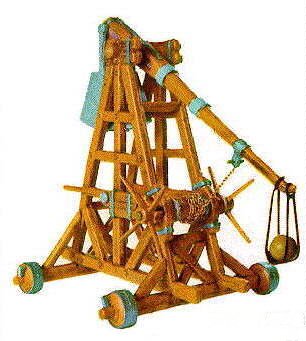
You're likely to see catapults similar to the one shown above in many an epic movie set in the Medieval period. They were fearsome siege devices; they would sling heavy rocks or other projectiles over a substantial distance in an effort to breach the defenses of the targeted castle.
In today's entry from Tricks, Traps & Shots of the Checkerboard, Willie Ryan's classic, we present an aptly-named catapult in our game of checkers. Here's Willie's run-up and very brief description.
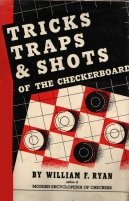
9-14, 22-18, 5-9, 24-19, 11-16, 26-22, 7-11---A, 22-17, 16-20---2, 30-26---B
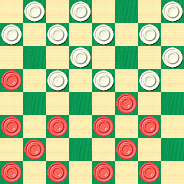
BLACK
Black to Play and Win
B:W32,31,29,28,27,26,25,23,21,19,18,17:B20,14,12,11,10,9,8,6,4,3,2,1.
A---"A somewhat inferior line of play---1, but the trap at B is well concealed.
B---Caught!"
1---We're not really sure why Willie calls this move inferior, as it seems to be the best move, with the computer evaluating 10-15 as slightly worse---Ed.
2---Definitely inferior to 11-15. Perhaps Willie misplaced Note A and meant to put it here---Ed.
Can you take the leap and solve this one? While you're finding the winning Black move, spring back and correct White's losing play at 30-26. This isn't a shot in the dark; it's scientific checkers at its best. When you're finished, fling your mouse to Read More to see the solutions and detailed notes.![]()
Really Easy

Some problems definitely fall in the "really easy" category; they're as simple as two plus two equals ... how much was that again? Oh, right, four--- in any integer arithmetic of base five or higher, to be a little more precise. (One could argue that two plus two equals four even in arithmetics of base four or base three, but the symbol "4" wouldn't exist. And in base two, the symbol "2" wouldn't even exist. We'll stop there!)
In checker terms, today's speed problem is also really easy even if it's a cut above the trivial. You won't need much time for this one; ten seconds is way too long but because of our innate generosity, we'll give you ten seconds anyhow.
When you're ready, click on the link below, solve the problem, then come back and click on Read More to check your solution.
November Speed Problem (very easy)
![]()
The Deckhand

The deckhand in the photo above appears to be contemplating some sort of difficult shipboard task, and she doesn't appear too anxious to get about her business. Can't say that we blame her; some pretty heavy work happens on a commercial sailing vessel.
We're sure, though, that you won't have similar reluctance in tackling today's checker problem, which was composed by Chris Nelson, who used the nom-de-plume of "The Deckhand." We don't know why Mr. Nelson, who was a denizen of Brooklyn, chose this pseudonym. Perhaps he was a spare-time sailor. But we can say for sure that he was a fine checker problem composer, as the offering below will handily demonstrate.
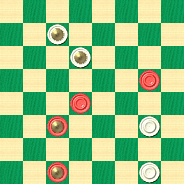
WHITE
White to Play and Win
W:WK6,K10,24,32:B16,18,K22,K30.
Get on board and solve this problem. It may not be as hard as shipboard labor, but it presents a nice little challenge. Then sail your mouse over to Read More to see the solution.![]()
A Thinker's Game

Those of us who play checkers in any sort of serious manner know very well that checkers is indeed a "thinker's" game, despite our oft-repeated laments that the general public doesn't usually share that opinion. Today's entry in our ongoing Checker School series demonstrates the fine line that can separate victory from just another drawn game; it takes a real thinker to see the difference between moves that look very similar but are far from it.
The situation is diagrammed below.
WHITE
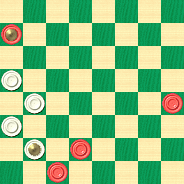
BLACK
Black to Play and Win
B:W20,16,12,K8:BK28,13,7,3.
You'll see in the solution notes and sample game the interesting manner in which this position came about, but for now, can you think your way to a Black victory, or will a thoughtless move give up your winning chances? Think it over, and then click on Read More to see the solution, thoughtful notes, and a sample game.![]()
The Jaywalker Gambit

If you visit Honolulu, you'd best not jaywalk; the fine is a whopping one hundred and thirty dollars, and the police don't hesitate to hand out the tickets. Jaywalking is a gambit you won't want to risk; it could really cost you.
There's a Jaywalker Gambit in checkers, too, and it won't cost you a cent to hear how Willie Ryan describes it in his classic book, Tricks Traps & Shots of the Checkerboard.

"The late great A. J. Heffner, of Boston, former Champion of America and heralded as one of the greatest analysts of all time, was responsible for christening the following trap 'the Jaywalker,' pointing out that many experts had wandered into it, unaware of their predicament until it was too late to bail out. The Jaywalker, a formational 'natural,' was originally rated drawable on the basis of Tillum and Aitchison's play, as quoted in the trunk game. But the eminent British authority, J. A. Kear, of Bristol, England, published an analysis indicating that, by introducing the 16-19 move at Note E, the gambit ended in defeat. Kear's play remained unchallenged for many years, but the data assembled here indicate that Kear's 16-19 move is nothing more than a transposition that ultimately runs back into the Tillum and Aitchison draw. Play:
| 11-16 | 30-26 | 7-10 |
| 24-19 | 11-16 | 26-22---2 |
| 8-11 | 22-17---A | 10-14, |
| 22-18 | 4-8 | forming the |
| 10-14 | 17-10 | diagram. |
| 26-22 | 6-24 | |
| 16-20 | 28-19 | |
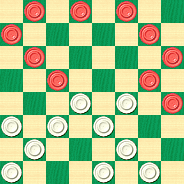
WHITE
White to Play and Draw
W:W32,31,29,27,25,23,22,21,19,18:B20,16,14,12,9,8,5,3,2,1.
A---A very weak move---1, forming the famous Jaywalker position. The correct play here for a draw is: 28-24, 4-8, 22-17, 7-10, 26-22, 3-7---B, 19-15, 10-26, 17-3, 26-30, 18-15, 6-10, 15-6, 1-10, 31-26, 30-23, 27-18, 20-27, 32-23, 9-13, 21-17, 5-9, 25-21, 2-7, 29-25, 7-11, 3-7, 10-14, 17-10, 16-20, 7-16, 12-26. Wm. F. Ryan.
B---White has a pretty trap here, for if the play goes 9-13, 18-9, 5-14, white wins by storm with: 19-15!, 10-26, 17-10, 6-15, 22-17, 13-22, 25-4, 26-30, 4-8. D. G. McKelvie."
1---The computer sees 22-17 as only very slightly worse than 28-24, so we're not sure why Willie thinks it's so weak. Perhaps the position is simply more difficult to play correctly---Ed.
2---Here's the real problem. The text move is substantially weaker than 25-22, though still not losing. Perhaps Willie should have flagged this move instead---Ed.
Don't be a jaywalker; walk the straight and narrow and solve the position. But we won't fine you if you don't get it; you can always safely click on Read More to see the solution and detailed notes.![]()
One Stroke
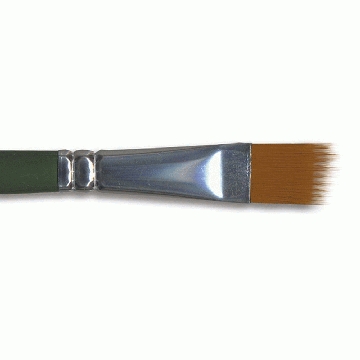
The item shown above is called a "one-stroke" brush, intended for use with the "FolkArt One Stroke" painting technique. Though we know very little about this brush technique, it certainly sounds fascinating.
We've never claimed to know a lot about our game of checkers, either, but today we present "one" stroke problem, and solving it it will call into play the technique of checker visualization, which we believe to be a fascinating art form in its own right.

WHITE
White to Play and Win
W:W32,24,23,22,19,18,17,16,K2:BK31,K27,25,20,15,11,10,7,3,1.
Now that's "one" stroke problem! Try to solve it without moving the pieces; when you've had your brush with this one, sweep your mouse to Read More to see the solution.![]()
Three by Three

Everyone's heard of a two by four (2x4), and there are other familiar sizes, such as 1x4 and the larger 4x4. But have you ever heard of a three by three (3x3)? There is such a thing, and in the strange world of "dimensional lumber" a 3x3 is in reality 2.5 inches by 2.5 inches.
Fortunately, there's no such thing as "dimensional checkers." A 2x2 or a 4x4 ending is just what the label implies. (We're not really sure where half a checker piece would fit in the scheme of things!) Today, we'll look at the 3x3 ending that's diagrammed below. It's from a game played over the board many years ago at a club in the St. Paul, Minnesota area.
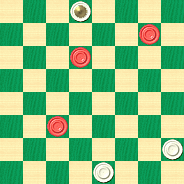
WHITE
White to Play and Win
W:W31,28,K2:B22,10,8.
Don't get cut down to size; sharpen your wits, not your saw, and see if you can solve the problem. When you have the answer, buzz your mouse on Read More to see the solution.![]()
Accurate Judgment

Accurate judgment is a necessary skill for success in the financial markets. If you're able to assess complex information such as that shown in the chart above, and then make the appropriate transactions, you've very likely got what it takes.
In the world of checkers, accurate judgment in endgames is also a critical element in expert play. The position below, from a Samuel Gonotsky game shown years ago by Willie Ryan, requires the keenest of judgment to find the draw.
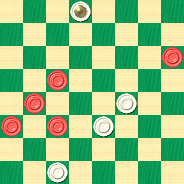
WHITE
White to Play and Draw
W:W30,23,19,K2:B22,21,17,14,12.
How good is your checker judgment? With White in a tough situation, this one is anything but easy and will definitely test your skill. When you've judged your line of play to be correct, click on Read More to see the solution.![]()
Are You Dunne, Yoeman?

There are various definitions of the word yeoman. The most well-known dates to the Middle Ages and refers to an independent landowner, usually of a small parcel, who farmed the land for a living. But yeoman is a naval rank in both the British and American armed forces, and of course yeoman is also a rank in the celebrated Star Trek television series. And then there are the Yeoman of the Guard.
Our picture above, however, is closer to home; it shows surfer Nathan Yeoman skilfully riding one of the heavies at the Banzai Pipeline on the famed North Shore of O`ahu.
There is a checker yeoman, too, or more correctly, Yoemans. He's partnered in with Frank Dunne in the pair of positions below, which form this month's Checker School offering.
BLACK

WHITE
White to Play and Draw
W:WK32,30,K15:BK27,23,21,K6.
J. R. YOEMANS
WHITE
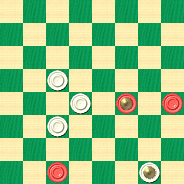
BLACK
Black to Play and Draw
B:W19,15,11,K1:BK14,13,3.
You may not be a Yeoman of the Guard, and it's unlikely (though certainly possible) that you've surfed the Pipeline, but we know you play checkers, and you can be a "Yeoman of Checkers" if you solve these problems. Give it your best and when you've caught the wave, click on Read More for the solutions, a sample game, and detailed notes.![]()
21st Century Checkers Volume 3

We're pleased and honored to present Volume 3 of Richard Pask's 21st Century Checkers series, on the 10-14s. Running well over 100 pages, this is sure to become the definitive modern reference. You can download the book in PDF format here.
As is the case with the first two volumes, the book makes extensive use of color, and if you desire a hard copy we recommend that you use a color printer loaded with plenty of paper and fresh ink cartridges. You can also send the PDF to a commercial printing service for professional printing and binding, though that will not be inexpensive.
Here's a "teaser" from the book.
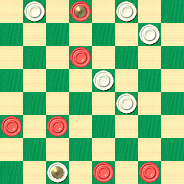
BLACK
Black to Play and Draw
B:W32,30,25,18,14,K3:BK31,23,12,11,2,1.
This is, obviously, at the expert level (or above!) but you should nevertheless give it a try and see what you can make of it. The solution is found on page 55 of Mr. Pask's new book.
We thank Mr. Pask for the privilege of presenting his work to the world-wide checker-playing community.![]()
The Checker Maven is produced at editorial offices in Honolulu, Hawai`i, as a completely non-commercial public service from which no profit is obtained or sought. Original material is Copyright © 2004-2025 Avi Gobbler Publishing. Other material is public domain, as attributed, or licensed under Creative Commons. Information presented on this site is offered as-is, at no cost, and bears no express or implied warranty as to accuracy or usability. You agree that you use such information entirely at your own risk. No liabilities of any kind under any legal theory whatsoever are accepted. The Checker Maven is dedicated to the memory of Mr. Bob Newell, Sr.

